Are water rates in Palo Alto high? You bet. It’s not just that we charge a lot. Our tiers are also very steep. As a result, tree-friendly Palo Alto charges residents 30-50% more than neighboring cities to water our trees, even though we get our water from the same source. How does the tiering work?
If you are going to use only 5 CCF of water in a month (1), our rates are not so bad. Palo Alto charges $7.42/CCF on top of a $21 meter charge. We are at least in the ballpark of most other cities.
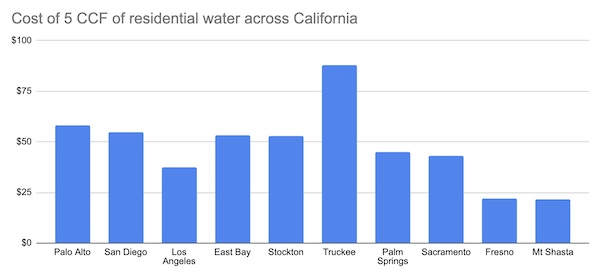
The main outlier is Truckee, which has a very high service charge. (That is the amount charged every month based on your meter size.)
Unfortunately, 5 CCF covers only indoor household use, if that, in many cases.

Once you use more than 6 CCF in one month, Palo Alto charges 50% more, or $10.96/CCF. That means we quickly assume the #1 spot on the pricing chart for a 10 CCF month.
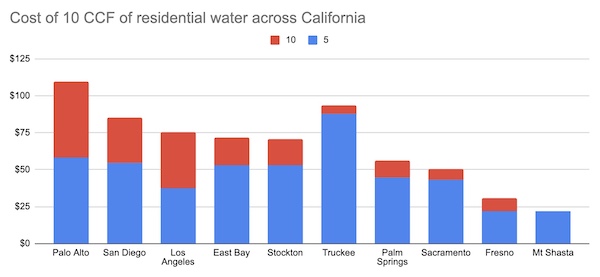
A summer watering month might be more like 20 CCF than 10 CCF for houses with lots of green landscaping. That picture looks similar. On the plus side, our rates do encourage us to save water and use drought-tolerant plants. But it seems wrong that we are charging 42% more than thirsty Los Angeles and 26% more than water-starved San Diego.
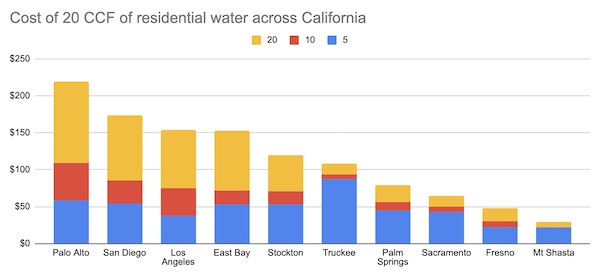
One thing I noticed about the rate structure for Los Angeles water is it has a much more generous tiering system than we do, one that supports rather than penalizes green landscaping. Their tiering is more generous in summer, and also more generous for larger yards that can accommodate more landscaping. Is that a gift to the wealthy? Or a gift to our local flora and fauna? Or both?
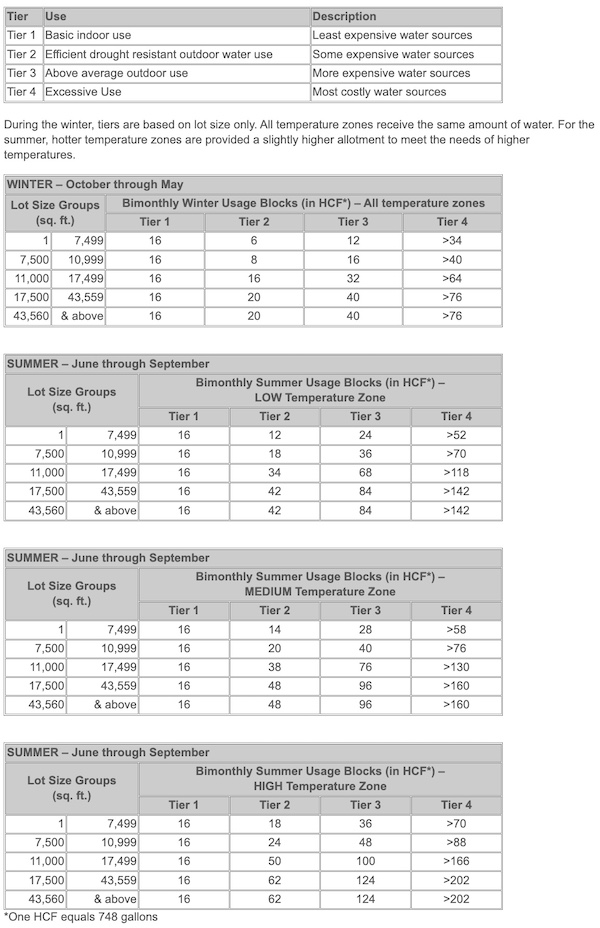
As one example of Los Angeles' tiered prices, if your yard is up to 7500 square feet, their lower-cost “Tier 2” pricing at $8.73/CCF allows 3 CCF for monthly watering most of the year, and anywhere from 6-9 CCF during the June-September months. This is on top of 8 CCF for indoor use at $7.52/CCF. In contrast, Palo Alto’s rates shoot right up to $10.96 after 6 CCF. It is pricey to water plants here.
The relative water costs look pretty much the same for a 40 CCF month, though that seems like a huge amount of water for a single household.
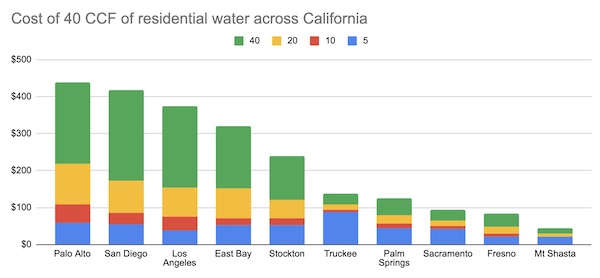
If you want to enjoy a water-heavy lifestyle, I recommend Mount Shasta. Or, interestingly, Palm Springs aka the desert. You can use 40 CCF there for about what it costs to use 10 CCF in Palo Alto. No, I don’t understand that either. Alternatively, water is essentially free in Truckee. It helps to be near the mountains!
In case you are wondering, water rates are high all over the Peninsula. It’s not just Palo Alto, and in fact San Francisco just edges us out.

Menlo Park and Mountain View both get their water largely from Hetch Hetchy, as we do, but both provide some allocation for the yards in single-family homes. They allow for 12-15 CCF of water to single-family homes before charging their highest rate. Palo Alto, in contrast, allows only 6 CCF. As a result, Palo Alto charges 55% more than Mountain View ($10.96 vs $7.09 per CCF) for tree and other landscape irrigation, and 30% more than Menlo Park ($10.96 vs $8.40 per CCF). How is that consistent with Palo Alto's identity as a tree-friendly city?
I am surprised by just how much variation there is in water costs across the state, and by the fact that water is more expensive here than anywhere else I looked, even SoCal and the desert. I am also disappointed that Palo Alto seems to be the only local city that makes no allowance for landscaping. In contrast, I am impressed with the thought that Los Angeles has put into the cost of irrigation. Palo Alto should do better. I also hope that in the future we will have an option to water our landscape with more local, more plentiful, somewhat less pristine, and substantially less expensive water.
Notes and References
1. A CCF is a hundred cubic feet, which is about 748 gallons.
Current Climate Data (June 2022)
Global impacts, US impacts, CO2 metric, Climate dashboard
There is a terrible heatwave in Europe right now, and much of the Southern Plains and Texas have been baking in record-setting heat. It will just get worse until we act. And yet 51 US Senators are unwilling to pass legislation that would help us develop, adopt, and compete in low-emission technology.
Fortunately, there is an incredible amount happening locally, at the state level, and in all of your households and workplaces, and I am thrilled and grateful to be able to write about it!
Comment Guidelines
I hope that your contributions will be an important part of this blog. To keep the discussion productive, please adhere to these guidelines or your comment may be edited or removed.
- Avoid disrespectful, disparaging, snide, angry, or ad hominem comments.
- Stay fact-based and refer to reputable sources.
- Stay on topic.
- In general, maintain this as a welcoming space for all readers.



